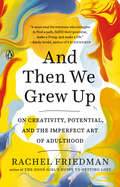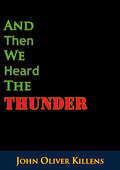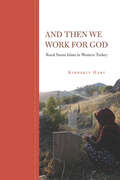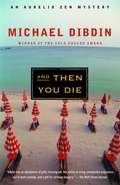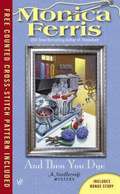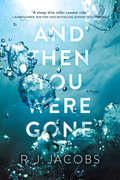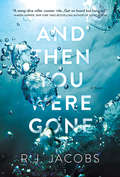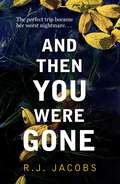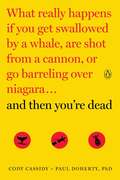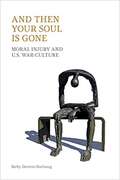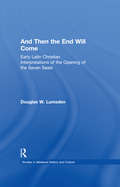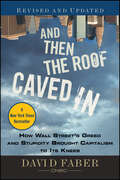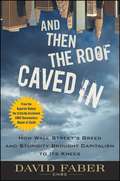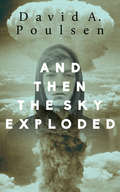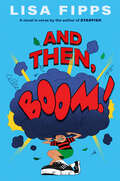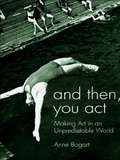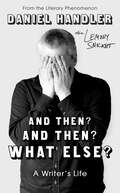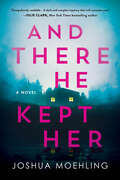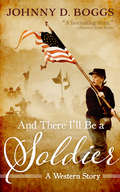- Table View
- List View
And Then We Grew Up: On Creativity, Potential, and the Imperfect Art of Adulthood
by Rachel FriedmanOne of Publishers Weekly&’s Best Books of 2019 A journey through the many ways to live an artistic life—from the flashy and famous to the quiet and steady—full of unexpected insights about creativity and contentment, from the author of The Good Girl&’s Guide to Getting Lost.Rachel Friedman was a serious violist as a kid. She quit music in college but never stopped fantasizing about what her life might be like if she had never put down her bow. Years later, a freelance writer in New York, she again finds herself struggling with her fantasy of an artist&’s life versus its much more complicated reality. In search of answers, she decides to track down her childhood friends from Interlochen, a prestigious arts camp she attended, full of aspiring actors, artists, dancers, and musicians, to find out how their early creative ambitions have translated into adult careers, relationships, and identities. Rachel&’s conversations with these men and women spark nuanced revelations about creativity and being an artist: that it doesn&’t have to be all or nothing, that success isn&’t always linear, that sometimes it&’s okay to quit. And Then We Grew Up is for anyone who has given up a childhood dream and wondered &“what-if?&”, for those who have aspired to do what they love and had doubts along the way, and for all whose careers fall somewhere between emerging and established. Warm, whip-smart, and insightful, it offers inspiration for finding creative fulfillment wherever we end up in life.
And Then We Heard The Thunder
by John Oliver KillensA fictional portrayal of real events that occurred during WWII from Afro-American author John Oliver Killens, who had previously served in the Amphibian Forces in the South Pacific. Through his characters, the reader gains a close-to-the-bone account of what it was like to be a Negro soldier fighting in segregated units under racist commanding officers. The final chapters reveal one of the war's best-kept secrets concerning the escalating racial tension between black American GIs and their white commanding officers. The story climaxes in a terrifying race riot, which took place on the seedy night streets of South Brisbane in March 1942.Editorial Reviews:"...a big and powerful, angry novel, pulsating with love and hate, laughter and tears, sex and violence, and all the other juices of life."--Sidney Poitier"...that big, polyphonic, violent novel...calls James Jones to mind."--Saturday Review"...A beautiful and powerful book."--James Baldwin
And Then We Rise: A Guide to Loving and Taking Care of Self
by CommonFrom the multi-award-winning performer, author, and activist, a comprehensive program for addressing mental and physical health—and encouraging communities to do the same.Common has achieved success in many facets of his life and career, from music to acting to writing. But for a long time, he didn’t feel that he had found fulfillment in his body and spirit.And Then We Rise is about Common’s journey to wellness as a vital element of his success. A testimony to the benefits of self-care, this book is composed of four different sections, each with its own important lessons: "The Food" focuses on nutrition. "The Body" focuses on fitness. "The Mind" focuses on mental health. And "The Soul" focuses on perhaps the most profound thing of all—spiritual well-being. Common’s personal stories act as the backbone of his book, but he also wants to give his readers the gift of professional expertise. Here, he acts as the liaison to his own nutritionist and chef, his own physical trainer, and his own therapist, as well as to those who act as his spiritual influences.Wise, accessible, and powerful, And Then We Rise offers a comprehensive, holistic approach to wellness that will allow readers to transform their thinking, their actions, and, ultimately, their lives.
And Then We Work for God: Rural Sunni Islam in Western Turkey
by Kimberly HartTurkey's contemporary struggles with Islam are often interpreted as a conflict between religion and secularism played out most obviously in the split between rural and urban populations. The reality, of course, is more complicated than the assumptions. Exploring religious expression in two villages, this book considers rural spiritual practices and describes a living, evolving Sunni Islam, influenced and transformed by local and national sources of religious orthodoxy. Drawing on a decade of research, Kimberly Hart shows how religion is not an abstract set of principles, but a complex set of practices. Sunni Islam structures individual lives through rituals—birth, circumcision, marriage, military service, death—and the expression of these traditions varies between villages. Hart delves into the question of why some choose to keep alive the past, while others want to face a future unburdened by local cultural practices. Her answer speaks to global transformations in Islam, to the push and pull between those who maintain a link to the past, even when these practices challenge orthodoxy, and those who want a purified global religion.
And Then You Die (Aurelio Zen #8)
by Michael DibdinHaving survived an explosive assassination attempt, Italian police detective Aurelio Zen finds himself convalescing at a Tuscan seaside resort town, where he is under orders to lie low until he is to testify at a much-anticipated Mafia trial. The quiet- and the boredom- are relieved by the pleasant distraction of the beautiful Gemma, but just when he feels he is getting somewhere with her, a the discovery of corpse in his usual lounge chair brings his holiday to an abrupt end. Convinced that the Mafia has finally located him, the police put Zen on the move again, in startling directions. And Then You Die, Michael Dibdin's latest installment in the Aurelio Zen series, is a wicked, twisting tale that pits Zen against invisible assassins and the possibility of forced retirement. As the plot unfolds, and Zen ponders his uncertain future, bodies are stacking up around him. And Then You Die is another exceptionally surprising, consistently funny triumph from a master of the genre.
And Then You Die: A Novel
by Iris JohansenThe bestselling author of "The Ugly Duckling" and "Long After Midnight" delivers the relentlessly gripping tale of an American photojournalist who stands against deadly terrorists. National ads, including "USA Today". Copyright © Libri GmbH. All rights reserved.
And Then You Dye
by Monica FerrisBetsy Devonshire, full-time owner of the Crewel World needlework shop and part-time sleuth, has hooked more than a few crooks in the USA Today bestselling Needlecraft Mysteries. Now Betsy learns the hard way that a murder is still murder, any way you color it... Betsy is a natural-born yarnsmith--so it's only fitting that some of her favorite items to stock come from the dye-works of Hailey Brent. Hailey makes hand-dyed knitting wool, silk, soy, and corn yarns. She uses only natural vegetable dyes, creating soft and beautiful colors. Which means her yarns are expensive, but well worth it. Unfortunately, someone thinks they're worth killing for. When Hailey's body is discovered shot dead in her workshop, Betsy discovers that there was a lot about Hailey she would have never guessed. Like her penchant for stealing other's property for her own use. Her use of dangerous additives to create her so-called all-natural fibers. And a scheming mind that had made her more than one enemy. Now, Betsy must wring the truth from a bevy of colorful suspects. Because the truth just might mean the difference between living--and dyeing...
And Then You Were Gone: A Novel
by R. J. JacobsEmily manages her bipolar disorder well enough to work as a moderately successful child psychologist, and is building a serious relationship with her boyfriend Paolo. <p><p> When he wants to take her on an overnight sailing trip, Emily knows her medication, generous amounts of wine, and her attraction to Paolo will help her deal with her aversion to the water and forget the fact that she can’t swim. <p> But after a romantic night, Emily wakes up on the sailboat, completely alone, drifting through the waves.Her world is tuned upside down as she becomes a person of interest while grieving Paolo, never getting answers or closure to what happened to him. He was a strong swimmer, and she cannot believe he simply drowned. With her personal and professional life in shambles, Emily attempts to find out the truth and clear her name, discovering a deeper and more dangerous plot than she ever suspected. Fueled by her own mania, Emily questions her own judgment every step of the way.
And Then You Were Gone: A Novel
by R. JacobsFor fans of B. A. Paris and Mary Kubica comes a propulsive, twisting psychological thriller that asks, How can you save someone else if you can’t save yourself? After years of learning how to manage her bipolar disorder, Emily Firestone finally has it under control. Even better, her life is coming together: she’s got a great job, her own place, and a boyfriend, Paolo, who adores her. So when Paolo suggests a weekend sailing trip, Emily agrees—wine, water, and the man she loves? What could be better? But when Emily wakes the morning after they set sail, the boat is still adrift…and Paolo is gone.A strong swimmer, there’s no way Paolo drowned, but Emily is at a loss for any other explanation. Where else could he have gone? And why? As the hours and days pass by, each moment marking Paolo’s disappearance, Emily’s hard-won stability begins to slip.But when Emily uncovers evidence suggesting Paolo was murdered, the investigation throws her mania into overdrive, even as she becomes a person of interest in her own personal tragedy. To clear her name, Emily must find the truth—but can she hold onto her own sanity in the process?
And Then You Were Gone: the compulsive psychological thriller 'that takes hold and won't let go'
by R. J. JacobsTHEIR PERFECT TRIP... BECAME HER WORST NIGHTMARE.And Then You Were Gone is a totally addictive and twisting psychological thriller that will grip you from the very first page. Perfect for fans of Clare Mackintosh, Lisa Jewell, Fiona Barton, Shari Lapena and B.A. Paris.'A thrilling ride that kept me guessing until the end . . . Exceptional!' Rena Olsen, author of The Girl Before'A gripping psychological thriller filled with suspenseful twists and turns!' Brad Thor, number one bestselling author.For once, Emily Firestone feels her life is coming together. She has a great job and a boyfriend, Paolo, who adores her. So when Paolo suggests a weekend boating trip, it sounds idyllic - wine, water, and the man she loves. But when Emily wakes the morning after they set sail the boat is adrift... and Paolo has vanished. A strong swimmer, there is no way Paolo drowned. So how did he disappear? The days pass without any answers and Emily's world begins to fall apart. As the prime suspect she must do everything to clear her name...but what hidden secrets will she uncover in search of the truth?'Compulsively readable...this psychological thriller takes hold and won't let go.' Publishers WeeklyWHY READERS ARE COMPLETELY GRIPPED:'One of those psychological thrillers you absolutely cannot put down' ***** Goodreads reviewer'What a gripping ride, a psychological thriller with a difference, I could not put this book down.' ***** Goodreads reviewer'The story had me hooked from the first page...'Unputdownable' fits this book better than anything.' ***** Goodreads reviewer'A real rollercoaster of a read!' ***** Goodreads reviewer
And Then You're Dead: What Really Happens If You Get Swallowed by a Whale, Are Shot from a Cannon, or Go Barreling over Niagara
by Paul Doherty Cody CassidyA gleefully gruesome look at the actual science behind the most outlandish, cartoonish, and impossible deaths you can imagine What would happen if you took a swim outside a deep-sea submarine wearing only a swimsuit? How long could you last if you stood on the surface of the sun? How far could you actually get in digging a hole to China? Paul Doherty, senior staff scientist at San Francisco’s famed Exploratorium Museum, and writer Cody Cassidy explore the real science behind these and other fantastical scenarios, offering insights into physics, astronomy, anatomy, and more along the way.Is slipping on a banana peel really as hazardous to your health as the cartoons imply? Answer: Yes. Banana peels ooze a gel that turns out to be extremely slippery. Your foot and body weight provide the pressure. The gel provides the humor (and resulting head trauma). Can you die by shaking someone’s hand? Answer: Yes. That’s because, due to atomic repulsion, you’ve never actually touched another person’s hand. If you could, the results would be as disastrous as a medium-sized hydrogen bomb. If you were Cookie Monster, just how many cookies could you actually eat in one sitting? Answer: Most stomachs can hold up to sixty cookies, or around four liters. If you eat or drink more than that, you’re approaching the point at which the cookies would break through the lesser curvature of your stomach, and then you’d better call an ambulance to Sesame Street.From the Trade Paperback edition.
And Then Your Soul Is Gone: Moral Injury And Us War-culture
by Kelly Denton-Borhaug Equinox PublishingThe sharp and unforgiving suffering of the morally injured veteran cannot be fully understood, much less effectively addressed, without a comprehensive investigation of moral injury's underlying causes in American culture and society. This book exposes the threads of violence that tie together the naturalized dynamics of U.S. ways of war and militarization with collective practices of national distraction and self-deception. It shows how these same threads of violence are also tightly woven and sacralized in the tapestry of U.S. national identity, tragically concealing moral injury from greater consciousness, and sourcing its toxic growth - ironically - in the very lives of those the nation claims it most highly esteems, our military service members and veterans. Drawing on Claudia Card's philosophical framework, moral injury here is characterized as an atrocity, "a foreseeable intolerable harm caused by culpable wrongdoing." These atrocities are shown to be flash-points revealing important truths regarding the unlivable consequences of U.S. war-culture and highlighting the urgent need to rethink the meaning of U.S. nationalism, desacralize violence, and support life.
And Then the End Will Come: Early Latin Christian Interpretations of the Opening of the Seven Seals (Studies in Medieval History and Culture #1)
by Douglas W. LumsdenThis work examines a centuries-long intellectual tradition in the early Latin church linking the imagery associated with the opening of the Seven Seals of the Apocalypse with programs of ecclesiastical expansion and ascetic reform.
And Then the Rain Came
by Evelyn W. MinshullA compelling saga of the pagan world before the great flood and how four remarkable women choose to follow the one true God no matter what the cost. It is a dark time for the earth. Faith has degenerated into pagan worship, and God has found only one man, Noah, who is righteous. He and his family still worship the true God, Yaweh. Ridiculed for their faith in a God who cannot be touched or seen, the women of the ark stand with Noah as the time of reckoning approaches. In the last days before the flood, the women of Noah's family come to know themselves and their God as never before. As they struggle with their daily lives and their very human emotions, these four women face personal doubts as well as fears for the loved ones who must be left behind. And as they make final preparations to enter Noah’s ark and leave the only world they know, each must find her own refuge in the unfailing love of Yahweh. As the doors of the ark close, they realize there’s no turning back...they are about to embark on the most extraordinary journey any woman has ever made.
And Then the Roof Caved In
by David FaberCNBC's David Faber takes an in-depth look at the causes and consequences of the recent financial collapseAnd Then the Roof Caved In lays bare the truth of the credit crisis, whose defining emotion at every turn has been greed, and whose defining failure is the complicity of the U.S. government in letting that greed rule the day. Written by CNBC's David Faber, this book painstakingly details the truth of what really happened with compelling characters who offer their first-hand accounts of what they did and why they did it.Page by page, Faber explains the events of the previous seven years that planted the seeds for the worst economic crisis since the Great Depression. He begins in 2001, when the Federal Reserve embarked on an unprecedented effort to help the economy recover from the attacks of 9/11 by sending interest rates to all time lows. Faber also gives you an up-close look at where the crisis was incubated and unleashed upon the world-Wall Street-and introduces you to insiders from investment banks and mortgage lenders to ratings agencies, that unwittingly conspired to insure lending standards were abandoned in the head long rush for profits.Based on two years of research, this book provides deep background into the current credit crisisOffers the insights of experienced professionals-from Alan Greenspan to prominent bankers and regulators-who were on the front linesCreated by David Faber, the face of morning business news on CNBC, and host of the network's award winning documentariesFrom regulators who tried to stop this problem before it swung out of control to hedge fund managers who correctly foresaw the coming housing crash and profited from it, And Then the Roof Caved In shows you how the crisis we currently face came to be.
And Then the Roof Caved In: How Wall Street's Greed and Stupidity Brought Capitalism to Its Knees
by David FaberCNBC's David Faber takes an in-depth look at the causes and consequences of the recent financial collapse. And Then the Roof Caved In lays bare the truth of the credit crisis, whose defining emotion at every turn has been greed, and whose defining failure is the complicity of the U.S. government in letting that greed rule the day. Written by CNBC's David Faber, this book painstakingly details the truth of what really happened with compelling characters who offer their first-hand accounts of what they did and why they did it. Page by page, Faber explains the events of the previous seven years that planted the seeds for the worst economic crisis since the Great Depression. He begins in 2001, when the Federal Reserve embarked on an unprecedented effort to help the economy recover from the attacks of 9/11 by sending interest rates to all time lows. Faber also gives you an up-close look at where the crisis was incubated and unleashed upon the world-Wall Street-and introduces you to insiders from investment banks and mortgage lenders to ratings agencies, that unwittingly conspired to insure lending standards were abandoned in the head long rush for profits. Based on two years of research, this book provides deep background into the current credit crisis. Offers the insights of experienced professionals--from Alan Greenspan to prominent bankers and regulators--who were on the front lines. Created by David Faber, the face of morning business news on CNBC, and host of the network's award winning documentaries. From regulators who tried to stop this problem before it swung out of control to hedge fund managers who correctly foresaw the coming housing crash and profited from it, And Then the Roof Caved In shows you how the crisis we currently face came to be.
And Then the Sky Exploded
by David A. PoulsenHigh Plains Book Award — Shortlisted, Young Adult category When Christian learns his great-grandfather helped build the A-bombs dropped on Japan, he wants to make amends … somehow. While attending the funeral of his great-grandfather, ninth-grader Christian Larkin learns that the man he loved and respected was a member of the Manhattan Project, the team that designed and created the atomic bombs dropped on Japan during the Second World War. On a school trip to Japan, Chris meets eighty-one-year-old Yuko, who was eleven when the first bomb exploded over Hiroshima, horribly injuring her. Christian is determined to do something to make up for what his great-grandfather did. But after all this time, what can one teenager really do? His friends tell him it’s a stupid idea, that there’s nothing he can do. And maybe they’re right. But maybe, just maybe … they’re wrong.
And Then, Boom!
by Lisa FippsA gripping new novel in verse by the author of the Printz Honor-winning Starfish, featuring a poverty-stricken boy who bravely rides out all the storms life keeps throwing at himJoe Oak is used to living on unsteady ground. His mom can&’t be depended on as she never stays around long once she gets &“the itch,&” and now he and his beloved grandmother find themselves without a home. Fortunately, Joe has an outlet in his journals and drawings and takes comfort from the lessons of comic books—superheroes have a lot of &“and then, boom&” moments, where everything threatens to go bust but somehow they land on their feet. And that seems to happen a lot to Joe too, as in this crisis his friend Nick helps them find a home in his trailer park. But things fall apart again when Joe is suddenly left to fend for himself. He doesn&’t tell anyone he&’s on his own, as he fears foster care and has hope his mom will come back. But time is running out—bills are piling up, the electricity&’s been shut off, and the school year&’s about to end, meaning no more free meals. The struggle to feed himself gets intense, and Joe finds himself dumpster diving for meals. He&’s never felt so alone—until an emaciated little dog and her two tiny pups cross his path. And fate has even more in store for Joe, because an actual tornado is about to hit home—and just when it seems all is lost, his life turns in a direction that he never could have predicted.
And Then, You Act: Making Art in an Unpredictable World
by Anne BogartFrom well-known auteur of the American theatre scene, Anne Bogart, And Then, You Act is a fascinating and accessible book about directing theatre, acting and the collaborative creative process. Writing clearly and passionately, Bogart speaks to a wide audience, from undergraduates to practitioners, and makes an invaluable contribution to the field tackling themes such as: intentionality inspiration why theatre matters. Following on from her successful book A Director Prepares, which has become a key text for teaching directing classes, And Then, You Act is an essential practitioner and student resource.
And Then? And Then? What Else?: A Writer's Life
by Lemony Snicket Daniel HandlerYou never love a book the way you love a book when you are ten. Writing as Lemony Snicket, Daniel Handler has led several generations of young readers into that special and curious space of being hopelessly lost, and joyfully finding yourself, in the essential strangeness of literature. The wondrous and perilous journey of the Baudelaire orphans sprung from the author’s own path, from his childhood discovery of Baudelaire’s poetry through the countless peculiarities of his pursuit of a literary life—abject failure and startling success, breakthrough and breakdown, concordance and controversy—lit along the way by the books and culture he loved best. At once a personal memoir and a literary exploration, a how-to book and a critical inquiry, a sequence of stories and a series of events, And Then? And Then? What Else? is a book not just for anyone curious about the creator of Lemony Snicket, but for anyone who loved books when they were a child, and still loves them now.
And Then? And Then? What Else?: A Writer's Life
by Lemony Snicket Daniel HandlerA memoir from the beloved author behind the multimillion-copy bestselling A SERIES OF UNFORTUNATE EVENTS &‘Extraordinary... highly entertaining.&’ DAILY TELEGRAPH Known to most as Lemony Snicket, the tormented narrator of A Series of Unfortunate Events, Daniel Handler spends his days writing – for children and adults; film and television; and, occasionally, the accordion. Mainly, he writes about horrible things: orphans, abusive uncles, poison, murder, arson, bad grammar… A love letter to the consoling and terrifying power of books, And Then? And Then? What Else? traces Handler&’s life through morbid poetry collections, eccentric acting troupes, hazy midnight taxi rides, second-hand bookstores and psychiatric units. Traversing his personal canon from his first encounter with Baudelaire to Vladimir Nabokov, Elizabeth Bishop and The Pet Shop Boys, Handler offers a witty, poignant exploration of reading, writing and why we tell stories. &‘This erudite, vulnerable, funny and idiosyncratic book ranks among his best. Grown-up fans of Lemony Snicket will enjoy discovering the rest of the story.&’ WALL STREET JOURNAL
And There He Kept Her: A Novel (Ben Packard #1)
by Joshua Moehling"A dark and complex mystery that will consume you."—Julie Clark, New York Times bestselling author of The Last FlightThey thought he was a helpless old man. They were wrong.When two teenagers break into a house on a remote lake in search of prescription drugs, what starts as a simple burglary turns into a nightmare for all involved. Emmett Burr has secrets he's been keeping in his basement for more than two decades, and he'll do anything to keep his past from being revealed. As he gets the upper hand on his tormentors, the lines blur between victim, abuser, and protector.Personal tragedy has sent former police officer Ben Packard back to the small Minnesota town of Sandy Lake in search of a fresh start. Now a sheriff's deputy, Packard is leading the investigation into the missing teens, motivated by a family connection. As clues dry up and time runs out to save them, Packard is forced to reveal his own secrets and dig deep to uncover the dark past of the place he now calls home.Unrelentingly suspenseful and written with a piercing gaze into the dark depths of the human soul, And There He Kept Her is a thrilling page-turner that introduces readers to a complicated new hero and forces us to consider the true nature of evil.Follow Acting Deputy Sheriff Ben Packard back into Minnesota's North Country August 15th with Where the Dead Sleep.
And There I Stood with My Piccolo
by Meredith WillsonAnd There I Stood with My Piccolo, originally published in 1948, is a zesty and colorful memoir of composer Meredith Willson&’s early years—from growing up in Mason City, Iowa, to playing the flute with John Philip Sousa&’s band and the New York Philharmonic Orchestra, to a successful career in composing for radio and motion pictures in Hollywood. It was apparent to everyone, except maybe Willson himself, that he was on his way to something big.Lighthearted and inspiring, it is no surprise Willson&’s tales caught the attention of prominent Broadway producers. In 1957, just nine years after the publication of this book, The Music Man became a Broadway sensation, winning five Tony Awards, including Best Musical. Meredith Willson&’s musical comedy is to this day arguably the most produced and beloved musical in American culture.
And There I’ll Be a Soldier: A Western Story
by Johnny D. Boggs Chris AbellTormented by Southern partisans, Missouri farm boy Caleb Cole joins the Union’s Eighteenth Missouri. About the same time, down on the Texas coast, violin-playing Ryan McCalla, from a well-to-do family, enlists in the Confederacy’s Second Texas—mainly in the spirit of adventure—with some friends.The two teenagers are about to grow up quickly.Fate will bring the two together—along with a teenage girl from Corinth, Mississippi, when the Confederate and Union armies clash at Shiloh, Tennessee, and then again in the town of Corinth.They will learn that war is far from glorious.
